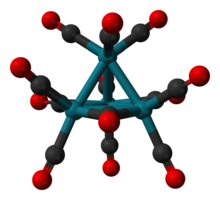 | |
| Names | |
|---|---|
| Other names cobalt dodecacarbonyl, cobalt carbonyl | |
| Identifiers | |
3D model (JSmol) | |
| ChemSpider | |
| ECHA InfoCard | 100.037.951 |
| EC Number |
|
PubChem CID | |
CompTox Dashboard (EPA) | |
| |
| |
| Properties | |
| Co4(CO)12 | |
| Molar mass | 571.858 g/mol |
| Appearance | black crystal |
| Density | 2.09 g/cm3 |
| Melting point | decomposes at60 °C (140 °F; 333 K) |
| Hazards | |
| GHS labelling: | |
   | |
| Warning | |
| H228, H301, H317, H331, H351 | |
Except where otherwise noted, data are given for materials in their standard state (at 25 °C [77 °F], 100 kPa). | |
Tetracobalt dodecacarbonyl is the chemical compound with the formula Co4(CO)12. It is a black crystalline compound that is insoluble in water and easily oxidized by air. It is an example of a metal carbonyl cluster.